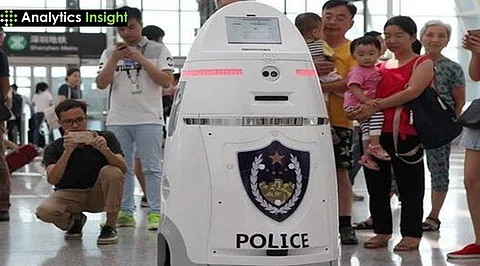

The integration of humanoid robots into law enforcement is a significant development with far-reaching implications. In China, EngineAI Robotics' PM01 robots are being deployed to support police operations, addressing the challenges posed by an aging population and dwindling workforce. This initiative raises important questions about the role of robotics in policing and its potential impact on public safety.
Robots represent one of the most significant investment opportunities in this country. Numerous reports from the International Federation of Robotics and similar organizations in Russia highlight this trend. In 2023, Chinese customers installed 276,288 robots, accounting for 51% of total global installations. One example of an advanced public humanoid robot is the PM01, which stands 1.38 meters tall and weighs 40 kg.
The intelligent manipulation interface, akin to the technology seen in Iron Man, serves as the interactive core of the machine, integrating its smart functions. This robot can patrol areas and assist in emergencies, featuring a waist that can rotate up to 320 degrees.
Increased investments in automation have been driven by a declining workforce and an aging population in China. The Communist Party views humanoid robots as a crucial component of its strategy for economic growth and self-reliance. The country aims to enhance public safety and address gaps in various sectors by deploying robots, such as the PM01. While these robots can assist with certain tasks, human police officers are better equipped to handle more complex issues, ultimately leading to a more effective law enforcement system.
Public interaction is perhaps the most intriguing aspect of these robots. PM01 was designed not just for surveillance purposes but also to engage with people, answer questions, and provide assistance. By taking a human approach, these robots may help bridge the technological trust gap within the community.
But can robots truly replace human contact in law enforcement? The reality is that public acceptance will play a crucial role in determining the sustainable future of robots in this field.
Humanoid robots deployed in China are sparking intriguing conversations about the future of law enforcement. Are these trends that other nations should consider emulating? Can robots work alongside human officers to create a more effective and efficient system?
While the technology of these humanoid robots is remarkable, it also presents several challenges. Key concerns include ethical considerations, data privacy, and the potential for misuse. With a cost estimated at Rs 10.5 lakh (88,000 yuan) per PM01 robot, this could also limit their adoption in other regions.
Humanoid robots, such as PM01, are now acting as change agents for public safety in China, addressing the demographic and workforce challenges affecting society. The media praises their technology and public interaction, while also raising questions about potential limitations, ethical concerns, and costs. These robots are not intended to completely replace human officers completely; rather, they are designed to work alongside them, enhancing the efficiency of policing. As China conducts its pilot study, the field of robotics is entering a new realm of law enforcement, potentially setting a precedent for the future. Could this become the new norm?
